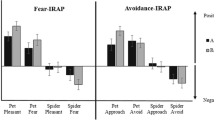Abstract
This research investigated the influence of reminders of mortality on biased attention for fear-relevant animals across 2 studies. In each study, participants completed a baseline dot-probe test of attention to fear-relevant animals (snakes and spiders). After random assignment, participants completed a mortality salience or control writing task (about watching television in Study 1 and about writing an important exam in Study 2). Finally, participants completed the dot-probe measure a second time. In both studies, those in the mortality salience condition showed a significant reduction in bias for fear-relevant animals from baseline to post-manipulation, whereas no change was found for those in the control conditions. These data suggest that the previously demonstrated lack of emotional response to mortality salience may, in part, result from the avoidance of fear-relevant stimuli.


Similar content being viewed by others
Notes
Another TMT paradigm examining the effects of subliminal death reminders has shown that non-conscious death primes lead to distal defenses without a delay (e.g., Arndt et al. 1997a).
References
Arndt, J., Allen, J. J. B., & Greenberg, J. (2001). Traces of terror: Subliminal death primes and facial electromygraphic indices of affect. Motivation and Emotion, 25, 253–277. doi:10.1023/A:1012276524327.
Arndt, J., Greenberg, J., Pyszczynski, T., & Solomon, S. (1997a). Subliminal exposure to death-related stimuli increases defense of the cultural worldview. Psychological Science, 8, 379–385. doi:10.1111/j.1467-9280.1997.tb00429.x.
Arndt, J., Greenberg, J., Solomon, S., Pyszczynski, T., & Simon, L. (1997b). Suppression, accessibility of death-related thoughts, and cultural worldview defense: Exploring the psychodynamics of terror management. Journal of Personality and Social Psychology, 73, 5–18. doi:10.1037/0022-3514.73.1.5.
Arndt, J., Schimel, J., & Goldenberg, J. L. (2003). Death can be good for your health: Fitness intentions as a proximal and distal defense against mortality salience. Journal of Applied Social Psychology, 33, 1726–1746. doi:10.1111/j.1559-1816.2003.tb01972.x.
Caruth, C. (1995). Trauma: Explorations in memory. Baltimore: Johns Hopkins University Press.
DeWall, C. N., & Baumeister, R. F. (2007). From terror to joy: Automatic tuning to positive affective information following mortality salience. Psychological Science, 18, 984–990. doi:10.1111/j.1467-9280.2007.02013.x.
Fox, E. (2004). Maintenance or capture of attention in anxiety-related biases? In J. Yiend (Ed.), Cognition, emotion, and psychopathology (pp. 86–105). Cambridge: Cambridge University Press.
Gray, J. A., & McNaughton, N. (2000). The neuropsychology of anxiety. New York: Oxford University Press.
Greenberg, J., Arndt, J., Simon, L., Pyszczynski, T., & Solomon, S. (2000). Proximal and distal defenses in response to reminders of one’s mortality: Evidence of a temporal sequence. Personality and Social Psychology Bulletin, 26, 91–99. doi:10.1177/0146167200261009.
Greenberg, J., Martens, A., Jonas, E., Eisenstadt, D., Pyszczynski, T., & Solomon, S. (2003). Psychological defense in anticipation of anxiety: Eliminating the potential for anxiety eliminates the effect of mortality salience on worldview defense. Psychological Science, 14, 516–519. doi:10.1111/1467-9280.03454.
Greenberg, J., Pyszczynski, T., Solomon, S., Simon, L., & Breus, M. (1994). Role of consciousness and accessibility of death-related thoughts in mortality salience effects. Journal of Personality and Social Psychology, 67, 627–637. doi:10.1037/0022-3514.67.4.627.
Greenberg, J., Simon, L., Pyszczynski, T., Solomon, S., & Chatel, D. (1992). Terror management and tolerance: Does mortality salience always intensify negative reactions to others who threaten one’s worldview? Journal of Personality and Social Psychology, 63, 212–220. doi:10.1037/0022-3514.63.2.212.
Greenberg, J., Solomon, S., & Pyszczynski, T. (1997). Terror management theory of self-esteem and cultural worldviews: Empirical assessments and conceptual refinements. In M. P. Zanna (Ed.), Advances in experimental social psychology (pp. 61–139). San Diego, CA: Academic Press.
Grillon, C. (2002). Startle reactivity and anxiety disorders: Aversive conditioning, context, and neurobiology. Biological Psychiatry, 52, 958–975. doi:10.1016/S0006-3223(02)01665-7.
Isaac, M., & Chand, P. K. (2006). Dissociative and conversion disorders: Defining boundaries. Current Opinion in Psychiatry, 19, 61–66. doi:10.1097/01.yco.0000194811.83720.69.
Lipp, O. V., & Derakshan, N. (2005). Attentional bias to pictures of fear-relevant animals in a dot probe task. Emotion, 5, 365–369. doi:10.1037/1528-3542.5.3.365.
Lipp, O. V., & Waters, A. M. (2007). When danger lurks in the background: Attentional capture by animal fear-relevant distracters is specific and selectively enhanced by animal fear. Emotion, 7, 192–200. doi:10.1037/1528-3542.7.1.192.
Mogg, K., & Bradley, B. P. (1999). Selective attention and anxiety: A cognitive-motivational perspective. In T. Dalgleish & M. J. Power (Eds.), Handbook of cognition and emotion (pp. 145–170). Chichester, England: Wiley.
Öhman, A., & Mineka, S. (2001). Fears, phobias, and preparedness: Toward an evolved module of fear and fear learning. Psychological Review, 108, 483–522. doi:10.1037/0033-295X.108.3.483.
Pyszczynski, T., Greenberg, J., & Solomon, S. (1999). A dual-process model of defense against conscious and unconscious death-related thoughts: An extension of terror management theory. Psychological Review, 106, 835–845. doi:10.1037/0033-295X.106.4.835.
Rosenblatt, A., Greenberg, J., Solomon, S., Pyszczynski, T., & Lyon, D. (1989). Evidence for terror management theory: I. The effects of mortality salience on reactions to those who violate or uphold cultural values. Journal of Personality and Social Psychology, 57, 681–690. doi:10.1037/0022-3514.57.4.681.
Simon, L., Greenberg, J., Harmon-Jones, E., Solomon, S., et al. (1997). Terror management and cognitive-experiential self-theory: Evidence that terror management occurs in the experiential system. Journal of Personality and Social Psychology, 73, 5–18. doi:10.1037/0022-3514.73.2.310.
Strachan, E., Schimel, J., Arndt, J., Williams, T., Solomon, S., Pyszczynski, T., et al. (2007). Terror mismanagement: Evidence that mortality salience exacerbates phobic and compulsive behaviors. Personality and Social Psychology Bulletin, 33, 1137–1147. doi:10.1177/0146167207303018.
Taubman Ben-Ari, O., & Findler, L. (2005). Proximal and distal effects of mortality salience on willingness to engage in health promoting behavior across the life span. Psychology & Health, 20, 303–318. doi:10.1080/08870440512331317661.
Wegner, D. M. (1994). Ironic processes of mental control. Psychological Review, 101, 34–52. doi:10.1037/0033-295X.101.1.34.
Acknowledgments
This work was supported by a Social Sciences and Humanities Research Council of Canada grant to the first author. I (G.M.) am grateful to the Canadian government for their support of social science research.
Author information
Authors and Affiliations
Corresponding author
Rights and permissions
About this article
Cite this article
MacDonald, G., Lipp, O.V. Mortality salience reduces attentional bias for fear-relevant animals. Motiv Emot 32, 243–250 (2008). https://doi.org/10.1007/s11031-008-9100-6
Received:
Accepted:
Published:
Issue Date:
DOI: https://doi.org/10.1007/s11031-008-9100-6




